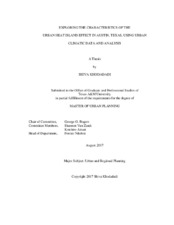| dc.contributor.advisor | Rogers , George O. | |
| dc.creator | Khodadadi, Shiva | |
| dc.date.accessioned | 2018-02-05T21:11:09Z | |
| dc.date.available | 2018-02-05T21:11:09Z | |
| dc.date.created | 2017-08 | |
| dc.date.issued | 2017-06-02 | |
| dc.date.submitted | August 2017 | |
| dc.identifier.uri | https://hdl.handle.net/1969.1/165787 | |
| dc.description.abstract | An urban heat island is an urban area with significantly warmer temperature than its surrounding. Reinforced energy and pollution problems, changed comfort zones, and threatened endangered-population necessitate the consideration of heat island effect in planning for urban areas. Human activities, city structures, lack of vegetation and cool sinks, and non-circulated air are defined as the variables that underpin heat island phenomen by increasing inner cities’ temperature. The heat island reduction can reduce the energy consumption within urban areas. The investigation of the characteristics of a heat island in a study on small-scale areas can provide more information about how to manage the increasing energy consumption in buildings.
This research explores the effect of urban development on increasing inner cities’ temperature. Austin was chosen as the study area because it experienced an average of 4.7 degrees C per year increase in the land temperature from 1993 to 2011. Also, the rapid development during the past 30 years let the researcher track the changes.
Secondary data assisted the researcher to conduct this research. The research developed a methodology to estimate urban heat intensities from atmospheric weather data and utilizing regression analysis to quantify urban development relation with urban heat island effect. Degree-day is an indirect measure for calculating the urban heat by considering the differences of the environmental temperatures from the standard base temperature. The warming trends have been calculated from the yearly sums of heating degree-days (HDD), and cooling degree-days (CDD) from 1939–2010. The ultimate results show that the heat island phenomenon is significantly related with land iii development only during the month of August. Also, CDD are significantly correlated to non-residential developments rather than the residential or total development. Therefore, recognizing heat mitigation strategies should be focused on non-residential sectors in order to reduce the CDD in summer. Moreover, the heat island phenomenon is not significantly dependent on the land development itself. Other issues that are associated with development may cause the significant increase in heat in Austin. | en |
| dc.format.mimetype | application/pdf | |
| dc.language.iso | en | |
| dc.subject | Heat Island Effect | en |
| dc.subject | Austin | en |
| dc.subject | Climatic Data | en |
| dc.title | Exploring the Characteristics of the Urban Heat Island Effect in Austin, Texas, Using Urban Climatic Data and Analysis | en |
| dc.type | Thesis | en |
| thesis.degree.department | Landscape Architecture and Urban Planning | en |
| thesis.degree.discipline | Urban and Regional Planning | en |
| thesis.degree.grantor | Texas A & M University | en |
| thesis.degree.name | Master of Urban Planning | en |
| thesis.degree.level | Masters | en |
| dc.contributor.committeeMember | Van Zandt, Shannon | |
| dc.contributor.committeeMember | Aitani, Koichiro | |
| dc.type.material | text | en |
| dc.date.updated | 2018-02-05T21:11:10Z | |
| local.etdauthor.orcid | 0000-0001-8425-4443 | |


